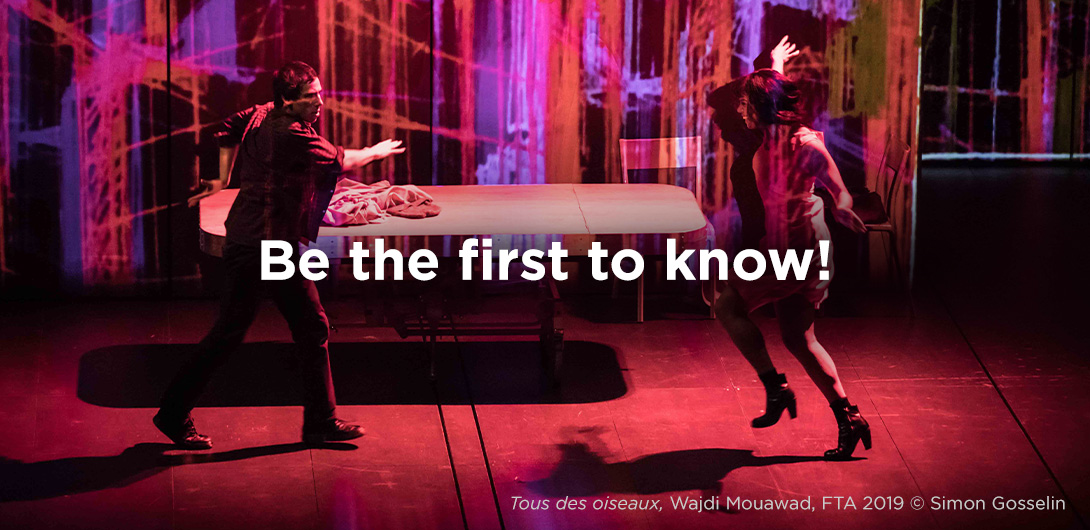For over 20 years, you’ve spent time together as friends, allies, artistic collaborators, and upholders of your Anishinaabe and Inga heritages. How did this deep shared history feed into your collaboration process?
Émilie Monnet: At the beginning, our aim was to create a platform for artistic exchange between Indigenous communities in the north and south. It was a slow process which took us years. The creative process is part of our personal relationship and has become an extension of our friendship and our respective commitments to social transformation. It also allows us to invite other collaborators to think about and create a new language with us, arising from interaction between multiple disciplines.
The creative process offers a space for sharing the words of those fighting on the front lines to defend the land and for creating bonds of solidarity. Indigenous women play a role in protecting water for future generations—but who defends them? This process is also a way of not feeling alone in the fight.
How does the land contribute to your theatrical languages?
Waira Nina: The creation of Nigamon/Tunai involves us in feeling the emotions that our bodies have experienced on the land, from violence to joy, from silence to listening to all those soundscapes that are only understood by those who have lived them. This process led us to share our personal stories and those of our peoples, to listen to the learnings of our grandmothers and grandfathers. None of these stories can be forgotten. We listen to the songs of north and south, of elders, of women; we listen to the statements made by people who defend their lands in order to protect them and live there in peace, co-existing with animals, as part of water. It’s very important to conserve these stories as part of each generation’s present.
Today, it rains a lot on our land, and it’s concerning to see the changes in the climate due to the world being imbalanced. We feel these changes in our lives as well. There’s an emotional and psychological imbalance caused by what’s happening on our lands. It’s felt among the younger generation too. The depth of water is forgotten, a memory disappears, a soundscape is hidden, because we are invaded by the noise of trucks, by roads seeking to cross our ancestral lands. But these are places that must be preserved because they possess tremendous spiritual power, because that’s where animals and plants are found.
In Nigamon/Tunai, you lose the sense of being trapped inside the four walls of the theatre and enter a space where you feel the warmth of other people, where plants talk, where water speaks, where the moon is connected to the shell of the turtle, which holds the Earth, which holds us.
Nigamon/Tunai features a multilingual sonic universe in which voices, silences, sounds, and songs co-exist. What kind of listening does this work encourage?
Waira Nina: In Nigamon/Tunai, there is a space for listening to the voices of grandmothers and children; the voices of protest and defense of the land against deforestation and the impact of mining and oil companies; spiritual voices and songs. The work also offers a space to listen to our own voices through various conversations and ceremonies that led to us finding deeper spiritual significance in our lives and lands.
The work also constructs personal listening landscapes, when we laugh and cry, when we give praise, when we purify ourselves. That leads to respecting the feelings of others, what they perceive. I wouldn’t like to think that the work imposes a single way of listening or interpreting; instead, we’re interested in the fact that each person listens based on their own lived experience. We don’t want to impose but rather to share a sound that comes from the deep feelings of our people, of women, of yacumamas. To feel the beating of the Earth’s heart, the heart of grandmothers, the heart of friendship. To feel in the rocks the sound of grandmothers’ words, because rocks keep their memory—an unwritten message that everyone can receive as a gift.
Personally, Nigamon/Tunai makes me feel that we need more alliances between north and south. You don’t necessarily need to understand the languages; the magic lies in feeling the song of language instead. And this kind of listening can sometimes be dark.
You’ve been collaborating with the Colombian artist Leonel Vázquez since 2014. How does his work fit with the notion of listening?
Émilie Monnet: Leonel is a sound and visual artist whose practice is based on sensitive listening and the sonic arrangement of elements such as water and rocks. The interaction of his practice with ours, along with our Indigenous cultures, enriches the plurilingual sonic universe that we offer the audience. On stage, we share the space with trees.
Water, birds, and wind blowing through the branches each have their own specific songs. But for many of us humans, our ability to listen has become impoverished. We can no longer recognize what a bird is telling us, nor are we able to communicate with other species. In Nigamon/Tunai, we try to explore another way of getting in touch with other beings, which is based on listening. How can we listen better and create a space for deep listening in order to hear the voices of our communities’ spiritual leaders, custodians of knowledge, those who are fighting to defend the land and save lives? Voices that others have often eradicated, oppressed, or tried to kill? Today, more than ever, it’s important that we listen to them, because that’s where answers may be found.










